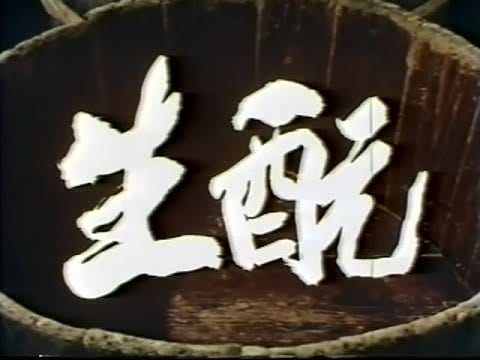This is How to Japanese, a monthly newsletter with something about Japan/Japanese, something about booze, and a dash of いろいろ.
日本・日本語: How to build a Japanese resignation message
I recently gave notice at my day job. While I gave official notice to my U.S. organization, informing our Japanese business partners was a critical step, and I wanted to make sure I did it right, so I spent an appropriate amount of time crafting a 退職 (taishoku, resignation) message. I found some interesting reference links while I was composing this message, so I thought it might be worth introducing those and the process I used to Frankenstein this text together.
First and foremost, the most important advice I can give you is this: Don’t get out over your skis. Only use Japanese that you understand.
As I’ve mentioned in the past (specifically with regard to COVID greetings, what こと means, and 取材), there is an enormous amount of Japanese linguistic support on the internet. You can find advice on how to say things in Japanese—especially if they’re work related—for almost any situation. You’re not expected to know these phrases off the top of your head (even if you’re Japanese), but at the same time, copying and pasting an example from the internet is not the most effective solution. You’ll end up sounding like someone else and not yourself.
I won’t post any of my specific writing, but I will share the sentences and phrases that I used as models and the websites where I found them.
唐突なご報告で恐縮ですが、(Shototsu na gohōkoku de kyōshuku desu ga)
My apologies for the sudden announcement, but…
When I saw this phrase in this post, I immediately felt comfortable with it. 恐縮 (kyōshuku, being grateful/feeling obliged/being sorry) is a phrase I’ve been using for years after a college professor introduced it, and I was able to sub in the more casual 突然 (totsuzen, sudden) at the beginning of the sentence. This is a great “airbag expression” as one of my college senseis used to call them.
I found three great expressions in this article.
一身上の都合により4月30日をもちまして退職する運びになりました (Isshinjō no tsugō ni yori shigatsu sanjū nichi o mochimashite taishoku suru hakobi ni narimashita)
For personal reasons, I will be resigning from my position as of April 30.
Obviously I changed the dates here. I also adjusted the beginning because I had no problem sharing what I will be up to. 一身上の都合 (isshinjō no tsugō, for personal reasons) can be a useful phrase if you’re in a less comfortable work situation and don’t want to let them know where you’ll be going (which is a relatively normal thing to do, even in the U.S.).
ご厚情を賜りまして心から御礼申し上げます (Gokōjō o tamawarimashite kokoro kara orei o mōshiagemasu)
Thank you from the bottom of my heart for treating me so kindly.
This was the phrase that felt most unfamiliar and advanced, but I saw it in numerous different examples and was able to extract it from other more complicated verbiage to hopefully express with some grace exactly how wonderful my Japanese colleagues have been over the past three years.
再びお世話になることもあるかと思います (Futatabi osewa ni naru koto mo aru ka to omoimasu)
I think we may have the opportunity to work together again.
This phrase felt very comfortable grammatically. I was also able to supplement this and explain that I’ll hopefully be in Japan by the end of the year at the latest.
Here’s another example of that phrase above from a different article.
格別のご厚情を賜り、誠にありがとうございました (Kakubetsu no gokōjō o tamawari, makoto ni arigatō gozaimashita)
Thank you for treating me incredibly kindly.
I really liked 格別 (kakubetsu, particularly/exceptionally) here as a way to emphasize, so I kind of combined these two.
I found a way to cover the transition in this article.
退職までにしっかりと引き継ぎを行いますので、どうぞご安心ください (Taishoku made ni shikkari to hikitsugi o okonaimasu no de, dōzo go-anshin kudasai)
Please rest assured I will ensure a transition through the end of my term.
This was an important element. I didn’t want them to feel left without support. I added in some additional phrases about finding a replacement who would be able to speak Japanese. I didn’t need help crafting these specific sentences, but I did search for the word 応募条件 (ōbo jōken, requirement for application) to make sure I was expressing myself clearly.
We’re getting near the end of the message. This article was helpful here.
メールでのご報告となり大変申し訳ございません (Mēru de no go hōkoku to nari taihen mōshiwake gozaimasen)
I’m very sorry to send this update by email.
This was useful toward the end of the message before my sign-off. We had discussed letting them know over a Zoom, but that felt a little…fraught. My spoken Japanese is not as sharp as my written language right now, I’d say, and you just have more control over a written message. In addition, moving the process along more quickly felt important, and by letting them know over email, we were able to arrange a Zoom call that was more useful strategically.
Obviously this shifts if you are working in person in the same office as someone. Much of this language is geared toward writing, but you can adapt it for spoken. Gearing yourself up to deliver something like that, however, is beyond the scope of this month’s newsletter.
To sum up, this article provides a good outline for this kind of written message:
1. 退職する旨と退職日を簡潔に書きます (Taishoku suru mune to taishokuhi o kanketsu ni kakimasu)
Simply state the reason you are resigning and your end date.
2. これまでお世話になったお礼を伝えます (Kore made osewa ni natta orei o tsutaemasu)
Thank them for their support to this point.
3. 今後の身の振り方については、書ける範囲でOK (Kongo no mi no furikata ni tsuite wa, kakeru han’i de OK)
Write what you can about what you’ll be doing next.
4. 直接ご挨拶できない非礼を詫びます (Chokusetsu go-aisatsu dekinai hirei o wabimasu)
Apologize for not being able to tell them directly.
5. 文末の定型句を使います (Bunmatsu no tenkeiku o tsukaimasu)
Use a standard message-ending line.
6. 余韻を残す言葉で締めます(ただし簡潔に)。この場面では、通常使う定型句「よろしくお願いいたします」は不適切です (Yoin o nokosu kotoba de shimemasu (tadashi kanketsu ni). Kono bamen de wa tsūjō tsukau tenkeiku “Yoroshiku onegai itashimasu” wa futekisetsu desu)
Close with words they’ll remember (but do it simply). In this situation, the usual line “Yoroshiku onegai itashimasu” is inappropriate.
One quick note - I think よろしくお願いいたします can be used in some form here, but not on it’s own. You likely want to add in a 今後とも (Kongo to mo, “In the future as well”) or something like that to make it more contextually appropriate.
I’ll finish up by expanding on my plans: I’m enrolling in the Inter-University Center for Japanese Language Studies 10-month program starting in September. This will keep me fully occupied, so I’m planning to dial down this newsletter and blog posts for the next year. I’m still planning to put something out on all platforms (except for the podcast, which wraps up right at the beginning of September), but I’ll cut out the booze section and probably reduce the いろいろ as well. I’m certain I’ll have a lot to say about the language, but I anticipate a more focused newsletter for the near future.
As for what comes after IUC, I’m not sure. I’m going in with an open mind and hopes of spending more time on translation work when I come out the other side, and I’ll probably be coming back to Chicago unless something truly unexpected happens.
日本酒: 生酛 (Kimoto)
In May, the Postwar Japan Moving Image Archive shared a link to Toshio Matsumoto’s 1980 documentary 生酛 (Kimoto), recently uploaded to YouTube by the Japan Sake and Shochu Makers Association.


I finally got around to watching the whole thing, and it’s fantastic. I don’t have a taste for Nihonshu, to be honest, but I’m fascinated by the process. My brother bought me a copy of “Brewing Sake: Release the Toji Within” years ago, and reading it my eyes started to gloss over with the complexity of the process and the need for precise temperature control.
Basically, 生酛 (Kimoto) and 山廃 (Yamahai) are traditional techniques for naturally building the lactic acid required for a 酒母 (shubo, starter). In modern brewing, lactic acid is just added, whereas traditionally it was produced by naturally occurring lactic acid bacteria. Kimoto is older and requires dividing up the “moto” and stirring it frequently to dissolve the rice. Yamahai accomplishes this, I believe, with enzymes and temperature control alone.
You get a sense of exactly how labor-intensive the kimoto process of building a yeast starter is in the movie.
I was struck by how much contact there is with skin and other non-sanitized/sterile items.
Which is why the lactic acid is so important: It kills other microorganisms and enables the yeast to outcompete.
This chart shows the growth of different organisms:
Over time the lactic acid builds up, killing off everything else, and then eventually the yeast thrives and begins to ferment. Fascinating. I’m sure that range of microorganisms present at the beginning of the process contributes flavor and aroma elements that would not be present in a 速醸酛 (sokujōmoto, literally: “rapidly brewed moto”) with artificially added lactic acid. This sounds very similar to lambic production: There are bacteria active for a very short period of time that eventually succumb to the acidic/alcoholic environment, and in the end Saccharomyces dominates.
Because the auto-generated subtitles are not great, I recommend reading this article in English and this article in Japanese before you watch the movie. The Japanese one is especially helpful in terms of vocabulary.
いろいろ
Bonus 退職 information: This is a crazy detailed article on 運びとなる (hakobi to naru, “it has come to be that…”) and even includes a look at the difference between the use of に and と in the phrase.
The Cicerone Program is now selling single-serving off-flavor kits! This is a game changer. Previously you could purchase off-flavor kits for a group, but it was difficult and expensive to organize. The sets include six standard off flavors in small vials. You spike a “neutral” flavored beer (basic lager/lightly hopped pale ale/golden ale) and then test your perception of the flavors. Highly recommended for anyone interested in expanding their beer knowledge.
Mezcal Mal Bien put together an Agave Flavor Wheel. This looks to be super helpful, and I’m planning to break it out the next time I’m tasting.
いい年 continues to pop up! This time in a news segment about new types of “harassment” that got shared on Twitter. I shared my thoughts on the blog as bonus coverage for my last two Japan Times articles.










